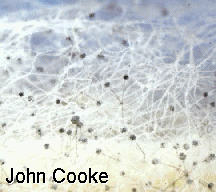
| |
 |
![]()
 Copyright 1997 Alan T. Hagan. All rights
reserved.
Copyright 1997 Alan T. Hagan. All rights
reserved.
Republished in part by express permission. Please note Disclaimer below.
Entire text also available as an ftp download.
Molds are fungi just like mushrooms and yeast. Also like mushrooms, they reproduce by releasing spores into the air that land on everything, including your food and food storage containers. When those spores begin to grow, they create thin threads that spread through out their growing medium. These threads are the roots of the mold fungus, called mycelium. The stalk of a mold fungus is the portion above or on the surface of the food. It produces the spores and gives the mold its color. We've all seen examples of this when we discover a dish of something or other left way-y-y too long in the refrigerator and has become covered in mold fuzz.
Molds can grow anywhere they have a growing medium (their food), sufficient moisture and enough warmth. Some can even grow at refrigerator temperatures, albeit more slowly than they would if it were warmer. They can also withstand much more salt and sugar than bacteria, which is why you sometimes find mold in jellies and jams with their high sugar content and on cured products like ham or bacon with their high salt content.
In the past, it was often felt a slight amount of mold was harmless and the food could be consumed anyway. For molds that were intentionally introduced into the food, such as the mold in bleu cheese, this is just fine. For the unintentional molds, it can be a very serious error in judgment. These unwanted molds might just be producing a toxic substance called a "mycotoxin" which can be very bad indeed. Mycotoxins are produced around the root or mycelium of the mold and the mold roots can penetrate very deeply into the food. These mycotoxins can survive for a long time in foods, and unfortunately most are not destroyed by cooking. The molds probably best known for this are the various Aspergillus varieties which produces a mycotoxin known as "aflatoxin", but there are other dangerous molds as well, such the Fusarium molds. Both of the above affect grain and some legumes.
In wet pack foods such as your home canned goodies, molds can do something else, possibly leading to lethal consequences. If they are present in wet pack food by reasons of improper procedure or contamination after the fact, they can consume the natural acids present in the food. The effect of this is to raise the pH of the food in the container, perhaps to the point that it becomes possible for spores of Clostridium botulinum, better known as "botulism", to become active and reproduce. If you're not already aware of the consequences of botulism poisoning, please read the bacterial spoilage section .. where it has an entry all its own. This is the most deadly kind of food poisoning there is. For this reason, moldy wet pack foods should be safely discarded.
Molds in low acid foods canned by the pressure canning method are equally dangerous and should also be discarded in a safe manner.
DISCLAIMER: Safe and effective food storage requires attention to detail and proper equipment and ingredients. The author makes no warranties and assumes no responsibility for errors or omissions in the text, or damages resulting from the use or misuse of information contained herein. Placement of or access to this work on this or any other site does not mean the author espouses or adopts any political, philosophical or meta-physical concepts that may also be expressed wherever this work appears.